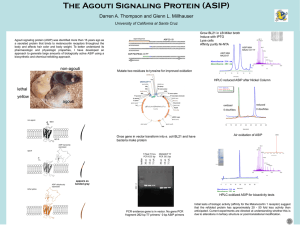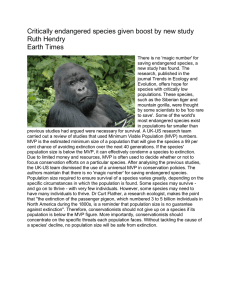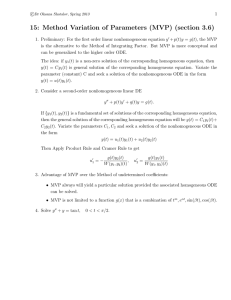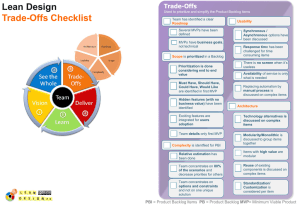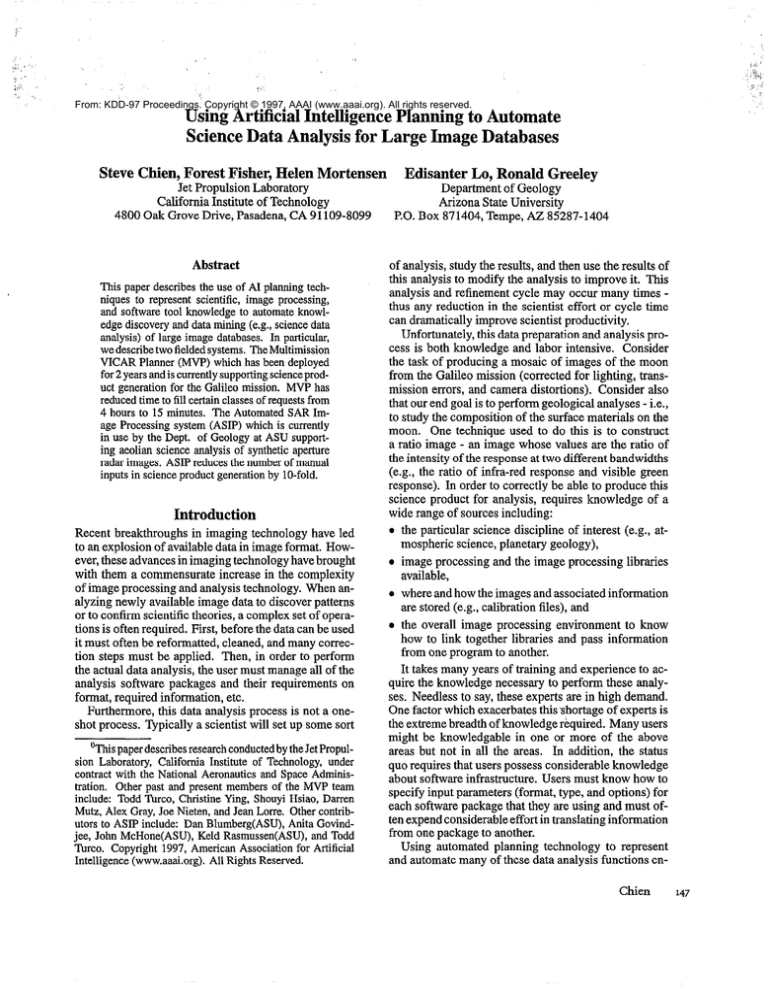
From: KDD-97 Proceedings. Copyright © 1997, AAAI (www.aaai.org). All rights reserved.
Using Artificial Intelligence Planning to Automate
Science Data Analysis for Large Image Databases
Steve Chien, Forest Fisher, Helen Mortensen
jet PropulsionLaboratory
California Institute of Technology
4800 Oak Grove Drive, Pasadena,CA 91109-8099
Abstract
This paper describesthe use of AI planning techniques to represent scientific, image processing,
and software tool knowledge to automate knowledge discovery and data mining (e.g., sciencedata
analysis) of large image databases. In particular,
we describetwo fielded systems.TheMultimission
VICAR Planner (MVP) which has been deployed
for 2 yearsand is currently supportingscienceproduct generation for the Galileo mission. MVP has
..^rl..“^A
‘GUULGU
G-n
lullrj
l ^
LV
fll
1111
^A..b.:..
I;Ulillll
-l.T”“^”
UilDSGB
^C,,,..^“h”
“I
Hxpwrs
c-nll”lll
4 hours to 15 minutes. The Automated SAR Image Processing system (ASIP) which is currently
in use by the Dept. of Geology at ASU supporting aeolian science analysis of synthetic aperture
radar images. ASIP reducesthe number of manual
inputs in scienceproduct generationby lo-fold.
Introduction
Recent breakthroughsin imaging technology have led
to an explosion of availabledatain imageformat. However,theseadvancesin imaging technologyhavebrought
with them a commensurateincreasein the complexity
of image processingand analysistechnology.When analyzing newly available image data to discoverpatterns
or to confirm scientific theories,a complex set of operations is often required. First, beforethe datacan be used
it must often be reformatted,cleaned,and many correction steps must be applied. Then, in order to perform
the actual data analysis,the user must manageall of the
analysis software packagesand their requirementson
format, required information, etc.
Furthermore,this data analysisprocessis not a oneshot process. Typically a scientist will set up somesort
“This paperdescribesresearchconductedby the JetPropulsion Laboratory, California Institute of Technology, under
contract with the National Aeronautics and Space Administration. Other past and present members of the MVP team
include: Todd Turco, Christine Ying, Shouyi Hsiao, Darren
Mutz, Alex Gray, Joe Nieten, and Jean Lorre. Other contributors to ASIP include: Dan Blumberg(ASU), Anita Govindjee, John McHone(ASU), Keld Rasmussen(ASU),and Todd
Turco. Copyright 1997, American Association for Artificial
Intelligence (www.aaai.org). All Rights Reserved.
Edisanter Lo, Ronald Greelev
”
Departmentof Geology
Arizona StateUniversity
P.O.Box 871404,Tempe,AZ 85287-1404
of analysis,study the results,and then use the results of
this analysisto modify the analysisto improve it. This
analysis and refinementcycle may occur many times thus any reduction in the scientist effort or cycle time
can dramatically improve scientist productivity.
Unfortunately,this datapreparationand analysisprocess is both knowledge and labor intensive. Consider
the task of producing a mosaic of images of the moon
from the Galileo mission (correctedfor lighting, transmission errors, and cameradistortions). Consider also
that our end goai is to perform geoiogicaianaiyses- i.e.,
to study the compositionof the surfacematerials on the
moon. One technique used to do this is to construct
a ratio image - an image whose values are the ratio of
the intensity of the response at two different bandwidths
(e.g., the ratio of infra-red responseand visible green
response).In order to correctly be able to producethis
scienceproduct for analysis, requires knowledge of a
wide rangeof sourcesincluding:
the particular sciencediscipline of interest (e.g., atmosphericscience,planetarygeology),
image processingand the image processinglibraries
available,
whereandhow the imagesand associatedinformation
are stored(e.g., calibration files), and
the overall image processingenvironment to know
how to link together libraries and pass information
from one programto another.
It takesmany years of training and experienceto acquire the knowledgenecessaryto perform these analyses. Needlessto say, theseexpertsare in high demand.
One factor which exacerbatesthis shortageof expertsis
the extremebreadthof knowledgerequired. Many users
might be knowledgablein one or more of the above
areasbut not in all the areas. In addition, the status
CIUO
-I-- reouiren
-- =-----
that
_._-_ users
--__-
nnasess
=--c---
con&&ie
knowledge
about softwareinfrastructure. Users must know how to
specify input parameters(format, type, and options) for
each softwarepackagethat they are using and must often expendconsiderableeffort in translatinginformation
from one packageto another.
Using automatedplanning technology to represent
and automate many of thesedata analysis functions enChien
147
ables novice users to utilize the software libraries to
mine the data (p. 50 (Fayyad96)). It also allows users
who may be expert in some areasbut less knowledgable
in other to use the software tools to mine the data.
The remainder of this article is organized as follows.
First, we provide a brief overview of the key elements
of AI planning. We then describe two fielded planning
systemsfor sciencedata analysis. We describethe MVP
system - which automates elements of image processing for science data analysis for data from the Galileo
mission. We then describe the ASIP system - which automates elements of image processing for science data
analysis of synthetic aperture radar (SAR) images.
The principle contributions of this article are twofold.
First, we identify software tool reconfiguration asan area
where AI planning technology can significantly extend
KDD capabilities. Second, we describe two systems
demonstrating the viability and impact of AI planning
on the KDD process.
Artificial
Intelligence
Planning Techniques
We have applied and extendedtechniquesfrom Artificial
Tntol1;nanr.e
~~,LV~~.~“.‘“V
Plcmninn
I 1U11111116
tn
L”
orlrlr~aa
UUUIVci.l
the
LllU
tnnrwl~Am~-h~cm-l
I.II”*“Iuu~u-“a~ul
software reconfiguration problem in general, and two
applications in science data analysis (e.g., data mining)
in specific. In order to describe this work, we first provide a brief overview of the key conceptsfrom planning
technology l.
Planning technology relies on an encoding of possible
actions in the domain. In this encoding, one specifies
for each action in the domain: preconditions,postconditions, and subactivities. Preconditions are requirements
which must be met before the action can be taken. These
may be pieces of information which are required to correctly apply a software package (such as the image format, availability of calibration data, etc. Postconditions
are things that are made true by the execution of the
actions, such as the fact that the data has been photometrically corrected (corrected for the relative location
of the lighting source) or that 3-dimensional topography
information has been extractedfrom an image. Substeps
are lower level activities which comprisethe higher level
activity. Given this encoding of actions, a planner is able
to solve individual problems, where each problem is a
current state and a set of goals. The planner uses its
action modeis to synthesize a pian (a set of actionsj to
achieve the goals from the current state.
Planning consists of three main mechanisms: subgoaling, task decomposition, and conflict analysis. In
subgoaling, a planner ensuresthat all of the preconditions of actions in the plan are met. This can be done by
ensuring that they are true in the initial stateor by adding
appropriate actions to the plan. In task decomposition,
the planner ensuresthat all high level (abstract) activities are expanded so that the lower level (subactivities)
are
emwr~s
that
~~ mesent
I~~~-~--. in
--- the
.--- rnlan.
__-__ This
----I------I__I I the
---- ~nlm
_I_^ cm--__
sists of executable activities. Conflict analysis ensures
that different portions of the plan do not interfere with
eachother.
The Multimission
VICAR
Planner (MVP)
MVP (Chien96) partially automates generation of image processing procedures from user requests and a
knowledge-basedmodel of VICAR image processing
area using Artificial Intelligence (AI) automated planning techniques. In VICAR image processing, the acL,,,
_“^ lITpI
Al3 111rdg~
:---.. -^^--^ :-- 11----------LIUIISSUE;
v 1~tux
puwssn~g
prugrams, aa.me current stateis the current stateof the image files of interest,
and the specification of the desired state correspondsto
the user image processing goals.
The VICAR environment (Video Image Communication and Retrieval 2 ) (LaVoie89) supports image processing for: JPL flight projects including VOYAGER,
MAGELLAN, and GALILEO, and CASSINI; other
spaceimaging missions such as SIR-C and LANDSAT,
and numerous other applications including astronomy,
earth resources, land use, biomedicine, and forensics
with a total of over 100 users. VICAR allows individual
processing steps (programs) to be combined into more
complex image processingscripts called procedure definition files (PDFs). The primary purpose of VICAR is
for encoding PDFs for science analysis of image data
from JPL missions.
An Example of MVP Usage
In order to illustrate how MVP assistsin VICAR planetary image processing,we now provide a typical example of MVP usageto ground the problem and the inputs
,-I“uq.JuLa
,x.,4....+”
,,..:..,,I I...
?&,n7D
:.-,.--” 511UWll
“1.^._.^
anu
IGqulLGu
vy I”1
Yr. TX,.
LUGd...“”
LIIIGGIlUqpS,
at the left of Figure 1 are of the planet Earth taken during
Figure 1: Raw and ProcessedImage Files
‘This name is somewhat misleading as VICAR is used to
nrn~~cc
y’“v”uY
rnn.irlm.ohl~
YVISU‘UVIUVI”
nnn-~,iA~n
.1v11- “IY””
imoc-.,a
am.h
“‘,Y6 ” rlato
ULICLI outi
LAN synthetic aperture radar (SAR) data.
148
KDD-97
QD M
At-321
LIU
I*Irl”A2JL-
the Galileo Earth 2 flyby in December 1992. However,
many corrections and processing stepsmust be applied
before the images can be used. First, errors in the compression and transmission of the data from the Galileo
spacecraft to receivers on Earth has resulted in missing and noisy lines in the images. Line fillin and spike
removals are therefore desirable. Second, the images
should be map projected to correct for the spatial distortion that occurs when a spherical body is represented
on a flat surface. Third, in order to combine the images,
we needto compute common points betweenthe images
and overlay them appropriately. Fourth, becausewe are
combining multiple images taken with different camera
states, the images should be radiometrically corrected
before combination.
MVP enablesthe user to input image processinggoals
through a graphical user interface with most goals as
toggle buttons on the interface. A few options require
entering some text, usually function parametersthat will
be included as literals in the appropriate place in the
generatedVICAR script. Figure 2 showsthe processing
goals input to MVP. Using the image processing goals
radiometric correction
pixel spike removal
missing line Iillin
uneven bit weight correction
no limbs presentin images
perform automaticnavigation
display automatic nav residual error perform manual navigation
map project with parameters. .
display man q av residual error
mosaic images
smooth mosaic seamsusing DN
Figure 2: Example Problem Goals
and its model of image processing procedures, MVP
constructs a plan of image processing steps to achieve
the requested goal. Figure 3 shows the plan structure
for a portion of the overall image processingplan.
In this graph, nodes represent image processing actions (programs) and required image states to achieve
the larger image processinggoal. This plan is translated
into a VICAR script which, when run, performs the
desired image corrections and constructs a mosaicked
Figure 3: Subgoal Graph for Manual Relative Navigation of Galileo Image Files
Figure 4: Sample VICAR Code Fragment
image of the three input files. Figure 4 shows tba MVPgeneratedVICAR code corresponding to this subplan
which performs image navigation 3 for a Galileo image.
The finished result of the image processingtask is shown
at the right in Figure 1. The three original images now
appearas a single mosaickedimage, map projected with
missing and corrupted lines filled in.
Thus MVP allows the user to go directly from high
level image processing goals to an executable image
processingprogram. By insulating the user from many
of the details of image processing, productivity is enhanced. The user can consider more directly the processinggoals relevant to the end science analysis of the
image, rather than being bogged down in the details such
as file format, normalizing images, etc.
MVP does not always fully automate this planetary
imaging task. In typical usage, the analyst receives a
request, determines which goals are required to fill the
request,and runs MVP to generatea VICAR script. The
analystthen runs this script and then visually inspectsthe
produced image(s) to verify that the script has properly
satisfied the request. In most cases, upon inspection,
the analyst determinesthat some parametersneed to be
modified subjectively or goals reconsidered in context.
This processtypically continues several iterations until
the analyst is satisfied with the image product.
Analysts estimate that MVP reduces effort to generate an initial PDF for an expert analyst from l/2 a day
to 15 minutes and reducesthe effort for a novice analyst
from severaldays to 1 hour- representing over an order
of magnitude in speedup.The analysts also judged that
the quality of the PDFs produced using MVP are comparable to the quality of completely manually derived
PDFs.
31mage
navigationis the processof determining the matrix
transformation to map from the 2-dimensional (line, sample)
coordinate space of an image to a 3-dimensional coordinate
spaceusinginformationon therelativepositionof theimaging
device (spacecraft position) and a model of the target being
imaged (e.g., the planetary body).
Chien
149
ASIP automates synthetic aperture radar (SAR) image
processingbasedon user request and a knowledge-base
model of SAR image processing using AI automated
planning techniques. ASIP enables construction of an
aerodynamic roughnessimage/map (z0 map) from raw
SAR data - thus enabling studies of Aeolian processes.
The aerodynamic roughnesslength (~0) is the height
above a surface at which a wind profile assumeszero
velocity. z0 is an important parameter in studies of
atmospheric circulation and aeolian sediment transport
Iin
\“A
‘1avmm-1~
UJ lllull”
tm-ma*
CVIIIIY.
wip,d
nnttPrnr
yU~CVll,c.,
rrr;nrl
““11.U
nm&nn
“l”Dl”l,
“ot
par-
terns, and sand/soil drift caused by wind) (Greeley87;
Greeley91). Estimating z0 with radar is important
because is enables large areas to be mapped quickly
to study aeolian processes, as opposed to the slow
painstaking process of manually taking field measurements(Blumberg95). The final science product is a
VICAR image called a z0 map that the scientists use
to study the aeolian processes.
ASIP is an end-to-end image processing system automating data abstraction, decompression, and (radar)
image processing sub-systems, and integrates a number of SAR and z0 image processing sub-systems. Using a knowledge base of SAR processing actions and
a general-purposeplanning engine, ASIP reasonsabout
the parameter and sub-system constraints and requirements: extracting needed parametersfrom image format and header files as appropriate (freeing the user
from these issues). These parameters, in conjunction
with the knowledge-baseof SAR processing steps,and
a minimal set of required user inputs (entered through
a graphical user interface (GUI)), are then used to determine the processing plan. ASIP representsa number
-D _-^___^f-- wnwdims
--.A-r-.e:..r-(e.g.,
I- - mdL
LL..’only
-..I.. some
_.
---1~
--. 01P
01 prucessmg
sunset
all possible combinations of polarizations are legal as
dependenton the input data). ASIP also representsimage processingknowledge about how to usepolarization
and frequency band information to compute parameters
used for later processing of backscatterto aerodynamic
roughnesslength conversion - thus freeing the user from
having to understandthese processes.
Figure 5 shows an aerodynamicroughnesslengthmap
of a site near Death Valley, California generatedusing
the ASIP system (the map usesthe L band (24 cm) SAR
with HV oolarization). Each of the greyscale bands
indicated dignifies a different approximate aerodynamic
roughnesslength. This map is then usedto study aeolian
processesat the Death Valley site.
Since the ASIP system has been fielded, it has proven
to be very useful in the use of generating aerodynamic
roughness maps with three major benefits. First, ASIP
has enabled a 10 fold reduction in the number of manual
inputs required to produce an aerodynamic roughness
map. Second, ASIP has enabled a 30% reduction in
CPU processing time to produce such a map (by producing more efficient plans). Third, and most signifi~~ ,1 lialr
1 .?TTI*nas enabled scientists to processtheir own
canuy
data (previously programming staff were required). By
150
KDD-97
Figure 5: Aerodynamic Roughness Length Map Produced Using ASIP
enabling scientists to directly manipulate that data and
reducing processing overhead and turnaround, science
is directly enhanced.
Conclusions
This paper has describedknowledge-basedreconfiguration of data analysis software using AI planning techniques. This represents an important area where AI
planning can significantly enhanceKDD processes.As
evidence of this potential, we described two fielded
planning systemsthat enhanceKDD: the MVP system,
which automates image processing to support Galileo
image data scienceanalysis; and the ASIP system which
automatesproduction of aerodynamic roughness maps
to support geological science analysis.
References
D. BlumbergandR. Greeley.“Field Studiesof Aerodynamic
RoughnessLength.”Jnl. Arid Environ.(1993) 2539-48.
S. A. Chien and H. B. Mortensen,“Automating Image
Processing for Scientific Data Analysis of a Large Image
Database,”IEEE Transactions on Pattern Analysis and Marhino
WA11.1” Tnt~llio~nr~
A..C”“.&“..YY
19
nn
IV CR(\*
\“,.
yp.
b2GL!2TO
“.,--“a/,
Allm-ot
r.uguuc
1006
I,,“.
K. Erol, J. Hendler, and D. Nau, “UMCP: A Sound and
Complete Procedure for Hierarchical Task Network Planning,” Proceedings of the 2nd International Conference on
AI Planning Systems,Chicago, IL, June 1994, pp. 249-254.
U. Fayyad, G. Piatetsky-Shapiro, F?Smyth, “From Data Mining to Knowledge Discovery in Databases,”AI Magazine,
Vol 17 No. 3, Fall 1996, pp. 37-54.
R. Greeley and J.D. Iversen, “Measurements of Wind Friction Speedsover Lava Surfaces and Assessmentof Sediment
Transport.“G.R.L. 14 (1987):925-928.
R. Greeley, L. Gaddis,A. Dobrovolskis,J. Iversen,K. Rasmussen, S. Saunders, J. vanZy1, S. Wall, H. Zebker, and B.
White. “Assessment of Aerodynamic Roughness Via Airborne Radar Observations.” 1991, Acta Mechanica Suppl.2,
77-88.
A. Lansky, M. Friedman, L. Getoor, S. Schmidler, and N.
Short Jr., “The Collage/Khoros Link: Planning for Image
Processing Tasks,”Proc. 1995 AAAI Spring Symp. on Int.
Planning Appl., pp. 67-76.
S. LaVoie, D. Alexander, C. Avis, H. Mortensen, C. Stanley,
and L. Wainio, VICAR User’s Guide, Version 2, JPL Internal
Document D-41 86, 1989.
J. S. Pemberthy and D. S. Weld, “UCPOP: A Sound Complete, Partial Order Planner for ADL,” Proc. 3rd Int. Conf.
Knowledge Representation and Reasoning, Ott 1992.

